2022 Porsche Taycan GTS First Drive: The Driver's EV To Beat
You could make a strong argument that the GTS is the epitome of the modern Porsche, and – by extension – that the new 2022 Taycan GTS is sweet spot in its electric line-up. Promising to combine enthusiast-pleasing performance with luxury and practicality, the GTS badge also debuts the first electric Sport Turismo, a third body style for the high-end EV.
It's certainly a case of "last, but not least": from its single model origins, there's now a GTS version of every two-door and four-door in Porsche's range. The Taycan GTS may not have a gas engine like its badge-mates, but that doesn't mean the Germans have forgotten the core appeal.
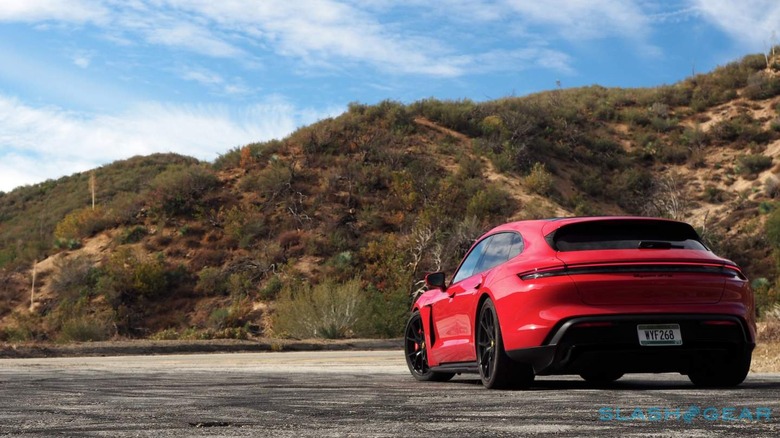
Porsche has the GTS styling recipe down to a fine art, by now, and the Taycan flavor doesn't stray too far from there. The front gets a SportsDesign bumper, more angular under the squinting headlamps to help funnel airflow into the side vents. LED-Matrix Design headlamps are standard, with Porsche Dynamic Light System Plus, though given a black finish unique among the Taycan range.
The skirts are unique, too, with high-gloss black inserts, and as standard the side mirrors are a mix of exterior color and gloss black. Optionally, you can have them match the body completely, or switch to carbon fiber. 20-inch Turbo S Aero Design wheels are standard, while the 21-inch RS Spyder Design wheels you see here – altogether shedding 11 pounds versus the next-lightest set – are available.
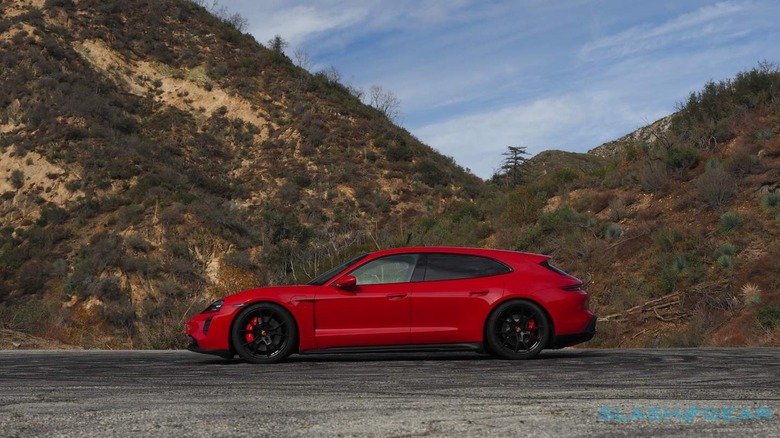
At the back, there's a new louvered-design red diffuser with more high-gloss black inlays. Porsche finishes things off with black logos and badging, along with matching black window trim and red brake calipers.
The result is clearly Taycan, but distinct enough to stand out in the EV crowd. To be more unique, of course, you can skip the standard Taycan and go straight to the Taycan GTS Sport Turismo. Unofficially the all-electric wagon enthusiasts have been blissfully dreaming of for years, it effectively takes the Cross Turismo body style but pairs it with the stance of the regular car and no plastic wheel arch cladding.
I happen to think the result looks epic – I am, I should point out, a big fan of wagons – but it's also considerably more flexible should you need extra convincing. More than 42 cu-ft of cargo space for a start, and 3.6-inches more rear headroom thanks to the change in roofline. Porsche will sell you not only roof rails to match, but a very fancy rear bike carrier that's rated to tote up to three bikes (including heavier e-bikes).
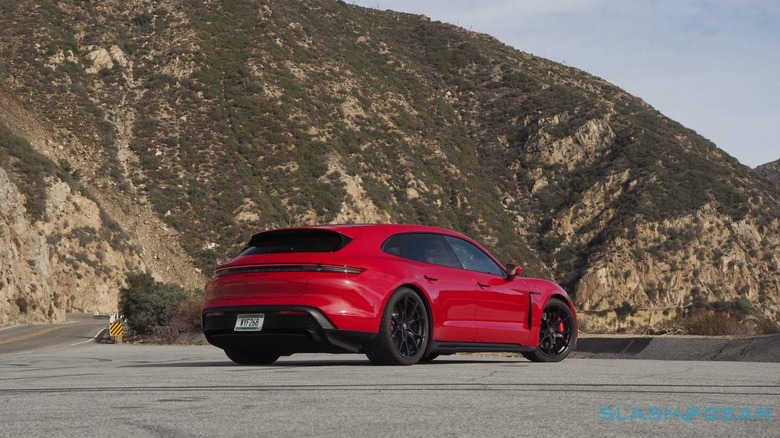
Much as with the styling, the performance strikes a balance between the current extremes of the Taycan line-up. 509 horsepower – 590 hp in overboost mode – may be lower than the Taycan Turbo, but the 626 lb-ft of torque is the same. 0-60 mph arrives in 3.5 seconds, an arguably negligible half a second slower than the Turbo, and top speed is an electronically-limited 155 mph.
What's important is how Porsche has achieved all that. Every all-wheel drive Taycan variant shares the same front electric motor, but the automaker has two sizes for the rear. The GTS uses the same unit as the Turbo and Turbo S – larger and more potent than that in the 4S – only programmed for less horsepower. The sacrifice not only saves you some money but also helps with thermal load since the rear motor doesn't have to work so hard, an important consideration if you're considering track days in your EV.
Porsche Active Suspension Management (PASM) is standard along with PTV+, together with 390 mm front brakes with 6-piston calipers and 358mm rear brakes. They're iron, but surface-coated and carbon ceramics are optional; so, too, is rear axle steering and dynamic chassis control. Pricing kicks off at $131,400 for the Taycan GTS and $133,300 for the GTS Sport Turismo (both plus $1,350 destination), though as with any Porsche you can easily send the sticker spiraling with extras.
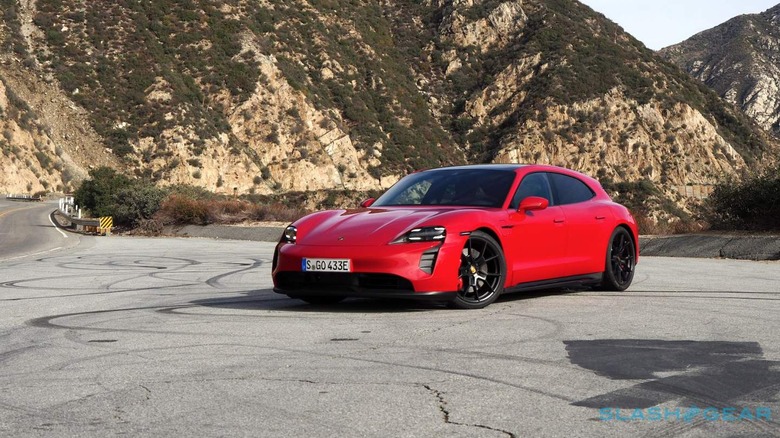
If you're reticent, don't take the test drive. The GTS badge has always unabashedly proclaimed a driver's car, maybe not the most potent or the very fastest in a straight line, but beguiling and engaging in a way the raw numbers can't quite express. The Taycan may switch out the gas engine, but the GTS spirit is here in spades.
It is, above all else, fun. Fun in the "turn around and run that good road again" sense; fun in the "take the long route home because it twists and turns a little more" way. A rock-solid reminder that chassis and suspension and drivetrain setup are as much alchemy as they are science.
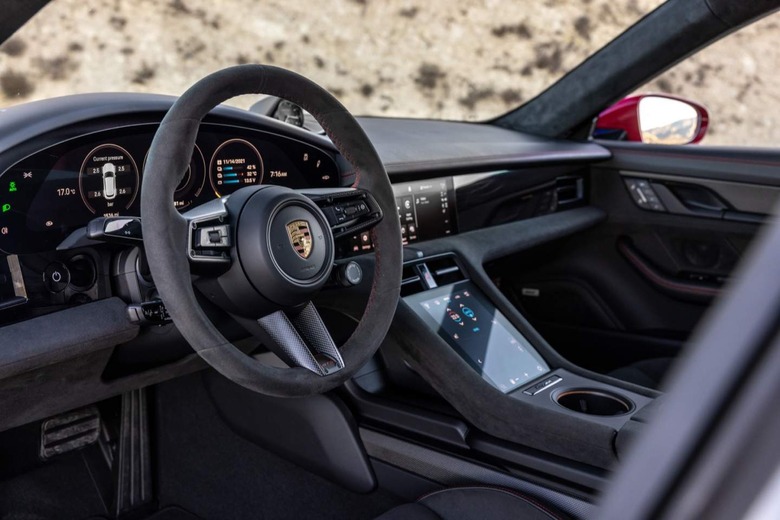
Being electric only helps, not hinders, all that. There are gas cars with similar horsepower and torque, true, but they don't give it all to you from the very get-go. The immediacy of their delivery turn the Taycan GTS into a rocket, belying the not-inconsiderable curb weight (5,077 pounds for the sedan and 5,152 pounds for the Sport Turismo).
You'd think, once you reached the first corner, that physics and heft would have their collective say. Instead, the GTS sails through the bends, communicative and eager. There are Sport and a Sport+ drive modes, both cranking up the experience, but even at its most uncapped there's none of that sense some fast cars give that you're flirting with things seriously out of your depth.
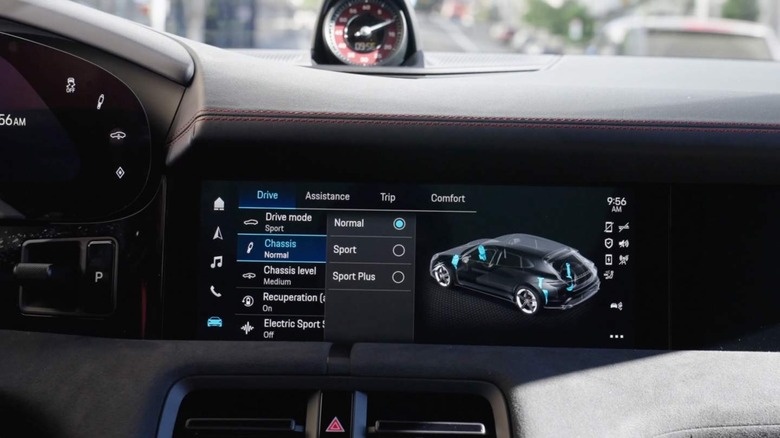
Could you still screw things up royally? Sure, though Porsche's blend of safety tech and dialed-in polish would give you plenty of warning before that actually happened. The result is a sense of reassurance that coaxes out a little more from you with every straight and corner that passes.
Perhaps the most immediately-noticeable difference between Sport and Sport+ modes is the soundtrack. Porsche cooked up a custom noise – inside and out – for the Taycan GTS, which it compares to the unique sounds that internal combustion GTS models with their sports exhausts produce. It's based on the actual sounds that the EV's motors make, albeit synthesized and modified, and then "optimally replayed" according to how you're driving.
The result is... not bad at all. Maybe the biggest complement I can pay is that I actually stopped noticing it most of the time: it just became a subconscious indicator of speed and motor power. If you want, you can turn it off with an easily-found option in the menus.
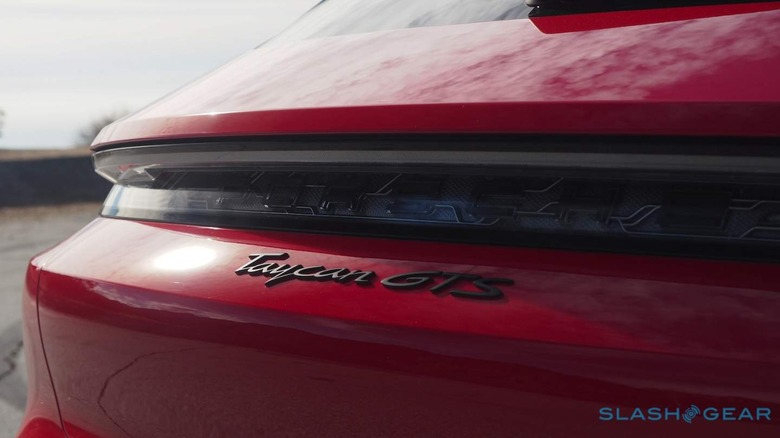
Weird electric burbling is something all EVs have had to deal with. One of the more controversial aspects of the Taycan in particular, though, has been Porsche's approach to regenerative braking. Contrary to many reports, the EV does make use of regen: in fact, it can gather 265-290 kW, model depending, during braking. What sets it apart from most electric rivals, though, is that Porsche expects you to manage that yourself with the brake pedal, rather than through a one-pedal driving mode.
Indeed, there's no such mode here, despite how convenient being able to control speed with the accelerator alone can be. Porsche's argument is that consistent pedal performance is more important, which isn't necessarily untrue. Its auto-regen mode – which uses the front-facing camera to magically adjust the regeneration levels depending on the speed and distance of the vehicle ahead – does rather undermine that a little, though it's so useful on the freeway that I can probably forgive the mixed-messages.
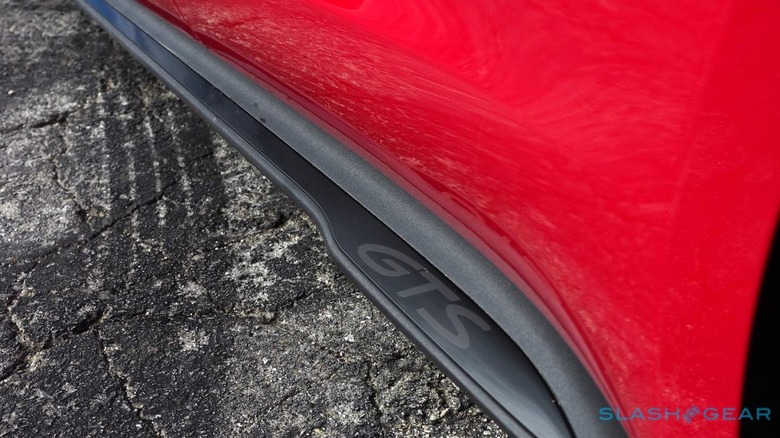
The big takeaway, however, is just how good the Taycan GTS is at shedding speed. A circular gauge on the dashboard shows how much of that is down to regen: when that fills up, the physical brakes weigh in. Most of the time, though, you're topping up the battery as you slow, and Porsche's brake action is gloriously predictable and easy to modulate. The point where the discs and pistons actually get involved is pretty much seamless, too.
Snick the drive mode dial on the steering wheel to "Normal," and the GTS puts in a surprisingly refined showing in rush hour traffic. The suspension is on the firm side, there's no denying that, but not so much as to be uncomfortable or crashy. Meanwhile, there's more than sufficient punch to squirt you between cross-lane gaps.
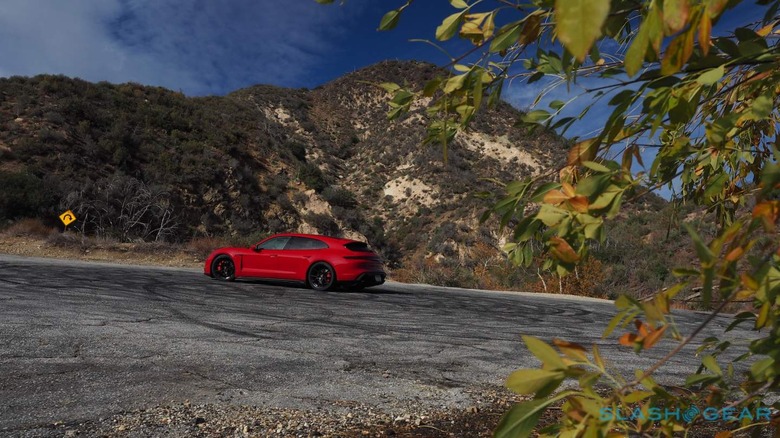
Lane-keeping assistance is standard, while adaptive cruise control is optional. So, too, is Porsche InnoDrive, its "Level 2.5" system which – courtesy of highway mapping and a bevy of sensors – promises to do things like lane-centering and adjust speed to upcoming turns. It's still a hands-on-wheel system (albeit relying on capacitive touch sensors in the wheel rather than application of torque), though.
Porsche is embracing over-the-air (OTA) updates, allowing the Taycan to incrementally improve – or, for that matter, owners with buyer's remorse to fill in some of the gaps on the spec sheet later down the line. If you bought ACC but not InnoDrive, for example, you can try a three month test subscription or just add the feature outright with a single payment. It stays with the car when resold, too.
In the future, assuming US safety regulators give the green light to so-called active headlamp tech, the Taycan could in theory get an OTA update to enable the 84 individual LEDs in each unit. That way they can each be controlled independently – just as they already are in Europe – for clever features like driving with high-beams without dazzling oncoming vehicles.
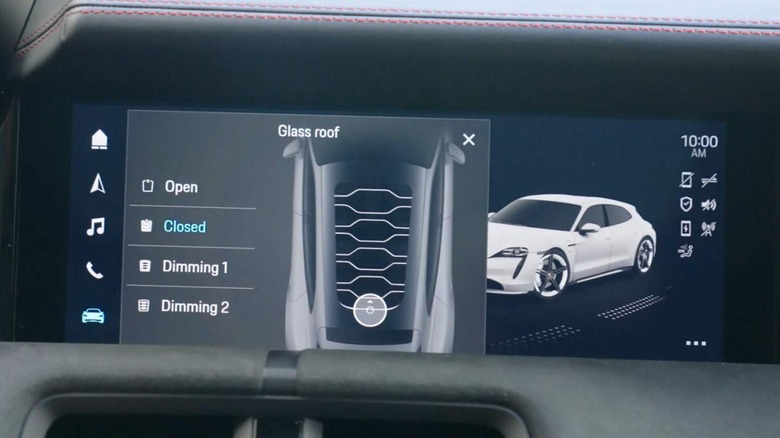
Something that can't be upgraded digitally – and which is well worth adding from the factory – is the Taycan's new Variable Light Control roof. It's a full glass panel, but split into nine segments that can each be set to transparent or opaque. As well as fully clear or fully dimmed, there are two patterns and the ability to swipe your finger across the touchscreen to treat the segments as a roller-shade.
Electrochromic sunroofs aren't new, but Porsche has used a liquid-crystal system instead. The result is much faster in operation – unlike existing tech, which can take 30+ seconds to dim or clear – and feels positively space-age in operation. It's available on both the GTS sedan and the GTS Sport Turismo.
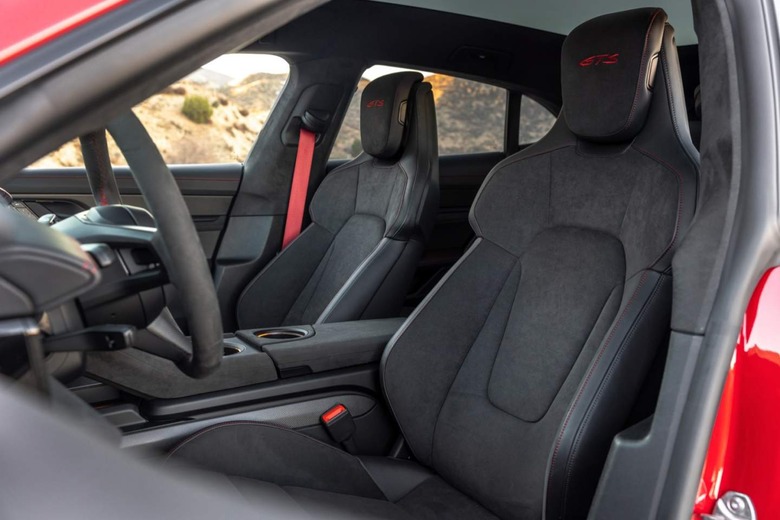
As for the rest of the cabin, the black brushed-aluminum interior package is standard, with 18-way Adaptive Sport Seats Plus with memory, GTS logos on the headrests, a heated GT Sport steering wheel in Race-Tex, and more Race-Tex on the roof lining and dashboard. An extended leather trim package is available, while the Sport Chrono package is standard.
Porsche does a reasonable job of skirting the line between high-tech dashboard and driver focus. The Sport Chrono stopwatch is the only analog gauge: everything else is digital, spread across three screens. The driver's graphics are clean and easy to follow, while two stacked touchscreens in the center console handle things like navigation, multimedia, HVAC, settings, and everything else.
I like Porsche's infotainment system, as offered on other recent models, though I'll need time in a US-spec car to see whether the Charging Planner lives up to the promises. In theory, it'll more intelligently precondition the battery for an upcoming charge: redirecting excess heat there from the motor, for example, if you're likely to end up at your next charging station before the battery pack would ordinarily warm up and support the fastest possible rates.
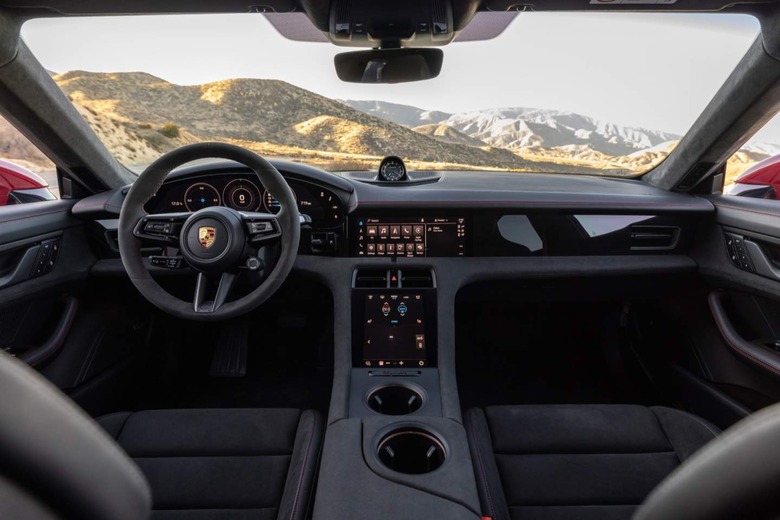
Range is still, of course, the stumbling block for many when it comes to considering an EV, and the Taycan hasn't had an easy time of it there. An underwhelming EPA rating, back when the Porsche first launched in the US, began an "on-paper versus real-world" saga that continues through to today, with many Taycan owners reporting their day to day experience with the car is that it lasts a lot longer than the official numbers would suggest.
Final range figures for the Taycan GTS' standard 94.3 kWh Performance Battery Plus haven't been shared yet. The less-powerful Taycan 4S is rated for 227 miles with that pack; the more-potent Taycan Turbo for 212 miles. With a 99% full battery, the dashboard estimate was 225 miles, but I wouldn't want to extrapolate from my day's enthusiastic driving as to what the GTS could achieve more generally.
What I can say, though, is that recharging is fast – if the stars align. With Porsche's 800 volt architecture and up to 270 kW DC fast charging support, locate the right plug and in theory you can go from 5% to 80% in under 23 minutes.
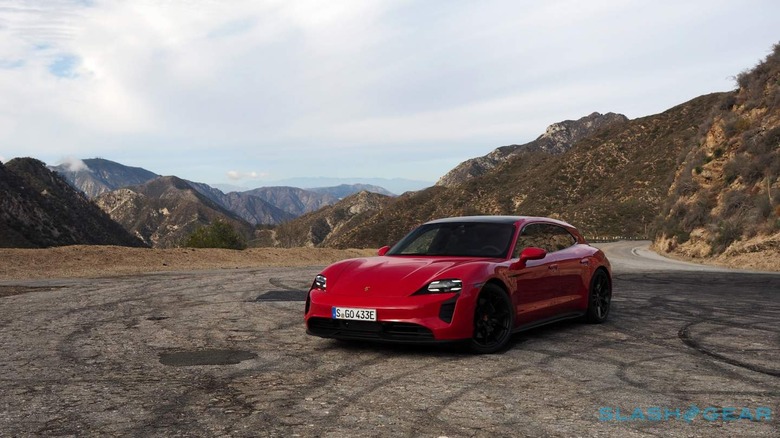
In practice, with an Electrify America 350 kW charger and the Taycan GTS at around 40%, I was adding juice at a rate of around 6.5 miles per minute according to the onboard computer. Obviously that'll depend exactly on how profligate you are with your right foot later, but it's genuinely fast nonetheless.
With Porsche lacking its own charging network, however – bar the hardware being installed at its dealers – you're at the mercy of third-party locations, and that can be a mixed bag. My Electrify America bay was working, but the one next to it wasn't, and drivers finding broken chargers (or, arguably even more frustrating, chargers that appear functional but when you plug them in simply... don't work) is a common complaint.
That's not, ostensibly, Porsche's fault, but it's a cold reality which will undermine the prestige experience of any high-end EV – particularly given the relative rarity of DC fast chargers even when they're all working.
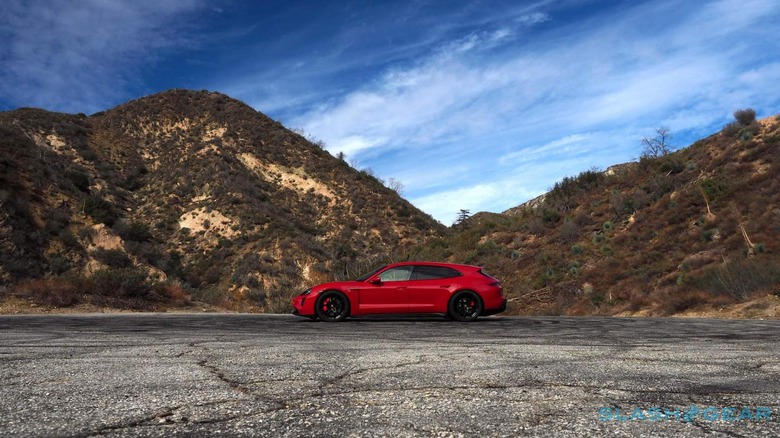
Nonetheless, such practicalities struggle to dim the appeal of the 2022 Taycan GTS. Like other Porsche models to wear that badge, it strikes a glorious balance in the heartland of the range. More rewarding performance than the cheaper Taycan variants, yet more attainable – and, frankly, more usable – than the expensive Taycan Turbo and Turbo S, it really does feel like the perfect configuration.
I suspect most will go for the Taycan GTS sedan, though it's tough to overstate the in-person allure of the Taycan GTS Sport Turismo. Pictures really don't do the EV justice. Either way, what stands out is how Porsche's enthusiast appeal is found in more than just how fast it can go in a straight line. 2022 looks set to bring some strong competition in the high-end electric category, but it already feels like the Taycan GTS will prove to be the benchmark when it comes to outright fun behind the wheel.
